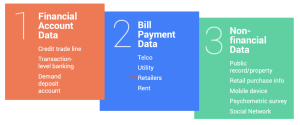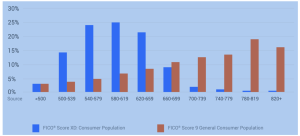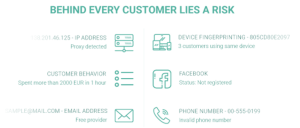The Hidden Perils of Climbing the Alternative Credit Ladder
Alberto Lopez Rueda
Alternative data could expand credit availability but in the absence of clear regulation, consumers should carefully consider the risks before asking for an alternative credit score
25 million Americans do not have credit history; they are “credit invisible”. This can make it very difficult to qualify for financial products, such as home mortgages or student loans. Credit is an important cornerstone of achieving the American dream [1] of homeownership, education and success which in turn is key in social mobility [2].
In order to access credit, consumers need to have a credit score. Yet, traditional credit scores are based on consumers’ credit history. How could millions of users dodge this “catch-22” problem and qualify for credit? Alternative data may be the answer according to some companies [3]. Alternative data is defined as any data that is not directly related to a consumer’s credit history and can include datasets such as individuals’ social media, utility bills and web browsing history.

Caption: Types of alternative data in credit scoring. Source.
Credit agencies argue that alternative data can build a more inclusive society by expanding the availability of affordable credit to generally vulnerable populations. But, at what cost?
Ethical and privacy concerns
The use of alternative credit scores raises important questions about transparency and fairness. In addition, some types of alternative data may entrench or even amplify existing social inequalities and could even discriminate against consumers based on protected characteristics like race. There are also hidden privacy risks, as companies generally collect vast amounts of data that can then be shared or re-sold to third-parties.
Alternative credit models are less transparent than traditional scores. Companies generally do not detail the alternative data that was utilized or disclose the methodology used to derive the alternative scores. Furthermore, alternative credit models are also harder to explain than traditional scores, due to the sophisticated models that produce the results. In addition, alternative data can contain potential errors and inaccuracies, which may be very challenging to detect or correct. Without full transparency, consumers’ risk being treated unfairly.
Alternative data may also perpetuate existing inequalities. According to data from FICO, one of the most known credit scoring companies, the FICO XD scores based on utility bills are meaningfully lower than those derived with traditional data. A low score can still provide access to credit although it generally means being charged higher interest rates or premiums. Receiving a FICO score below 580 [4] may even harm consumers since having a score classified as “poor” is generally worse than having no score [5]. However, these results cannot be generalized since the scores largely depend on the types of alternative data and algorithms used.

Caption: Distribution of FICO Scores between alternative data (FICO Score XD) and traditional scores (FICO 9). Source
New datasets could even facilitate discrimination against consumers. The Equal Credit Opportunity Act of 1974 forbids companies from using information from protected classes such as race, sex, and age for credit purposes. Yet, some alternative data indicators such as educational background [6] can be highly correlated to one of these protected classes.
Lastly, users of alternative data scores might be also exposed to meaningful privacy harms. Firstly, companies may collect vast amounts of information about consumers and although consumers are generally notified, they may not be aware the extent to which their privacy can be invaded. In addition, all this information collected could be shared or re-sold for completely different purposes, potentially harming consumers in the future.

Caption: Credit agencies can collect vast and detailed information about consumers
The US regulatory landscape around alternative data scores
In 2019, five US financial regulatory agencies [7] backed the use of alternative information in traditional credit-evaluation systems, encouraging lenders to “take steps to ensure that consumer-protection risks are understood and addressed”. Yet, most of the relevant regulation, such as the Fair Credit Reporting Act, dates back several decades and the advent of big data has inevitably brought some regulatory blind spots. It is imperative the US government enacts substantiative regulation for alternative credit scores to fulfil its potential. Important issues, such as the kinds of alternative data and indicators that can be used, must be addressed. Mechanisms should also be put in place to prevent discrimination, enhance transparency and protect consumers.
Without clear regulatory boundaries, vulnerable consumers might be forced to choose between a life without credit or a risky path of discrimination and lack of privacy. In other words: Dammed if you do, dammed if you don’t.
Conclusion
The advent of alternative data and new algorithms could help expand affordable credit to those who are credit invisible. More credit could in turn lower social inequalities by helping vulnerable consumers. Yet, the use of alternative credit scores remains in its infancy and the lack of explicit regulation can result in harmful practices against users. Against this backdrop, consumers should thoroughly compare the different alternative credit scores and carefully consider the sometimes-hidden disadvantages of climbing the alternative credit ladder.
Citations
[1] Barone, A. (2022, August 1). What Is the American Dream? Examples and How to Measure It. Investopedia.
https://www.investopedia.com/terms/a/american-dream.asp
[2] Ramakrishnan, K., Champion, E., Gallagher, M., Fudge, K. (2021, January 12). Why Housing Matters for Upward Mobility: Evidence and Indicators for Practitioners and Policymakers. Urban Institute
[3] FICO (2021). Expanding credit access with alternative data
https://www.fico.com/en/resource-access/download/15431
[4] McGurran, B. (2019, July 29). How to “Fix” a Bad Credit Score. Experian
[5] Black, M., Adams, D. (2020, December 10). Is No Credit Better Than Bad Credit?. Forbes
https://www.forbes.com/advisor/credit-score/is-no-credit-better-than-bad-credit/
[6] Hayashi, Y. (2019, August 8). Where You Went to College May Matter on Your Loan Application. The Wall Street Journal.
[7] Hayashi, Y. (2019, December 3). Bad Credit? Regulators Back Ways for Risky Borrowers to Get Loans. The Wall Street Journal.
